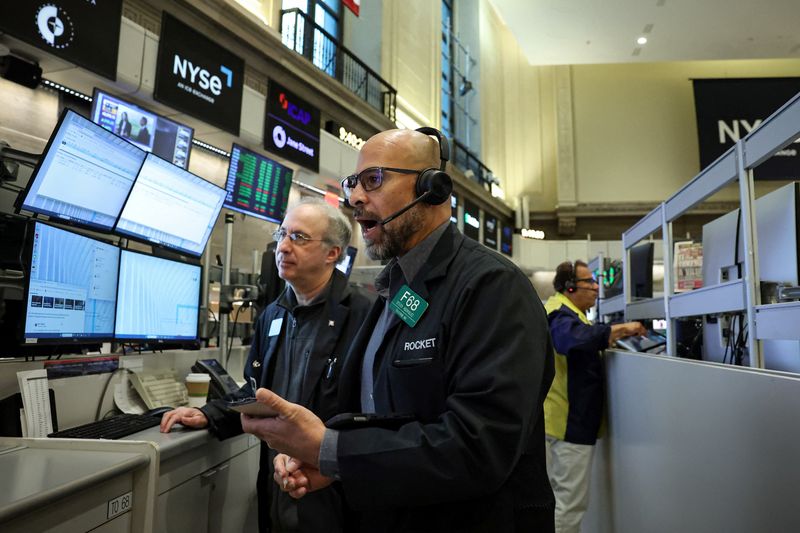
By Johann M Cherian and Noel Randewich
(Reuters) -Wall Street stocks were mixed on Monday as investors looked ahead to AI chipmaker Nvidia's quarterly earnings this week, digesting a rally on Friday that lifted the Dow Jones Industrial Average to a record high close.
On Friday, stocks jumped after Powell hinted at the Jackson Hole Symposium that an interest-rate cut could be considered at the central bank's September meeting, citing recent labor market weakness.
"The market has a Jackson Hole hangover," said Jake Dollarhide, CEO of Longbow Asset Management in Tulsa, Oklahoma. "Investors are taking a little bit of a breather."
The Personal Consumption Expenditures Price index - the Fed's preferred inflation gauge - is due to be released on Friday, while official nonfarm payrolls data is expected next week. The reports will be crucial, especially after Powell said a rate cut was not certain.
"The focus right now is the labor market," said Brian Klimke, investment director at Cetera Investment Management.
"We have the job market that's rolling over a little bit and the economy is weakening, so the Fed needs to act sooner than later and they're seeing it too."
Nvidia climbed 1.8% ahead of its quarterly report on Wednesday, which will be one of Wall Street's most closely watched events of the week and a crucial test of the scorching AI trade.
With Nvidia making up about 8% of the S&P 500, results of the world's most valuable company affect vast numbers of Americans who use index investment funds to save for their retirements.
"This is an incredibly important event from a market participant standpoint," said Michael Green, portfolio manager at Simplify Asset Management.
Powell's comments on Friday nudged major brokerages to revise their expectations, with Barclays, BNP Paribas and Deutsche Bank currently seeing a 25-basis-point reduction in borrowing costs next month.
Traders now see an 86% chance of a Fed rate cut in September, according to CME Group's FedWatch tool. Remarks from policymakers John Williams and Lorie Logan later in the day will be scrutinized to see if they share Powell's policy outlook.
The S&P 500 was down 0.16% at 6,456.86 points.
The Nasdaq gained 0.15% to 21,527.92 points, while the Dow Jones Industrial Average was down 0.60% at 45,358.95 points.
Friday's optimism helped the blue-chip Dow close at a record high for the first time since December 2024, and the benchmark S&P 500 logged its strongest one-day gain since May.
On Monday, Jefferies became the latest brokerage to raise its year-end target for the S&P 500.
Seven of the 11 S&P 500 sector indexes declined, led lower by consumer staples, down 1.23%, followed by a 1.2% loss in health care.
Beverage company Keurig Dr Pepper slid 9% after saying it would buy JDE Peet's for $18.4 billion in cash.
Furniture retailers RH and Wayfair declined more than 4% each after U.S. President Donald Trump said on Friday his administration would investigate furniture import tariffs.
Intel inched up 0.3% after Trump said the U.S. government was taking a stake in the chipmaker. He also said he would make other deals similar to the one with Intel.
Declining stocks outnumbered rising ones within the S&P 500 by a 3.3-to-one ratio.
The S&P 500 posted 13 new highs and no new lows; the Nasdaq recorded 115 new highs and 29 new lows.
(Reporting by Johann M Cherian and Sanchayaita Roy in Bengaluru, and by Noel Randewich in San Francisco; Editing by Pooja Desai and David Gregorio)

 Reuters US Business
Reuters US Business
 Reuters US Economy
Reuters US Economy Press of Alantic City Business
Press of Alantic City Business The Motley Fool
The Motley Fool Tulsa World
Tulsa World Associated Press US News
Associated Press US News NBC News
NBC News